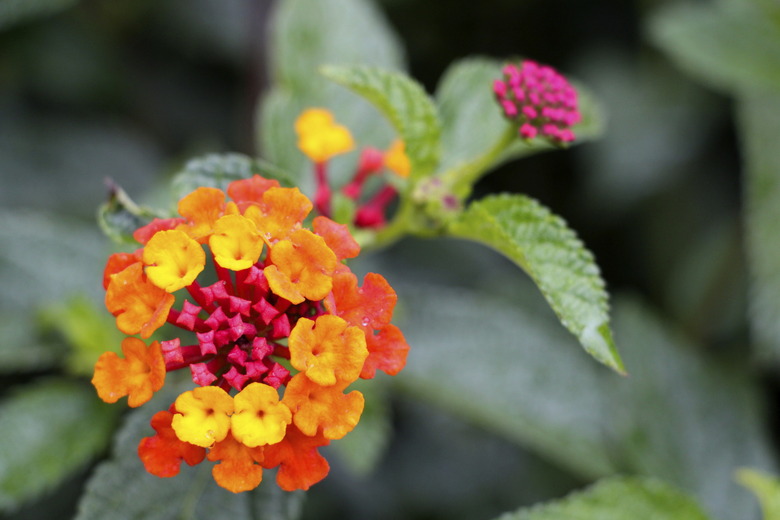How To Get My Lantana To Bloom
Lantana (Lantana spp.) bloom profusely under optimal conditions from late spring until the first frost, and it is generally easy to correct problems that hinder blooming. A member of the verbena (Verbenaceae) family, over 150 species of lantana exist. Most lantana species grow as annuals with some being perennial in U.S. Department of Agriculture plant hardiness zones 8 through 11. Lantana's clusters of tubular blossoms are colorful and attractive to butterflies and hummingbirds.
Blooming Problems
Blooming Problems
Common lantana (Lantana camara) and trailing lantana (Lantana montevidensis) are the most widespread species grown. Common lantana develops as a large shrub-like mound, and trailing lantana spreads across the ground. Hybrid sterile cultivars of all species bloom continuously because they do not set seeds. Hawaii, Texas and Florida classify some cultivars as invasive.
Issues causing lantana to stop blooming include not enough sun, too much fertilizer, cooler temperatures, lack of pruning, water-logged soil or the lantana lace bug.
Blooming Solutions: Sunlight, Temperatures and Fertilization
Blooming Solutions: Sunlight, Temperatures and Fertilization
If your lantana ceases blooming, it may need more direct sunlight or warmer temperatures. The heat-loving lantana requires at least four hours of full sun daily with temperatures at least 55 degrees Fahrenheit at night and at least 68 degrees F during the day.
Too much fertilizer causes lantana to stop blooming and become prone to disease. If your lantana is in a container, fertilize one or two times each month during the blooming season. Planted in the ground, lantana needs fertilization in early spring and mid-summer. Use a 12-4-8 liquid all-purpose plant food. Mix 4 teaspoons of fertilizer with two gallons of water. Water around each plant soaking down several inches into the soil.
Blooming Solutions: Pruning and Watering
Blooming Solutions: Pruning and Watering
To encourage blooming, continually deadhead lantana plants by removing faded blooms, seeds or berries throughout the blooming season from late spring until frost. In addition to deadheading, shear off the new growth on branch tips to boost repeat blooming.
Overgrown plants benefit from pruning off one-third of their size during the blooming season. After a hard pruning, water and fertilize immediately to help the plant recover and start blooming again.
Water-logged roots hinder blooming, so ensure soil around the lantana drains well. If container-bound, help lantana's roots breathe by punching at least four holes in the bottom if none exist. Water deeply once a week but allow the soil to dry between waterings. Lantana is drought-resistant, so err on the side of under-watering.
Blooming Solution: Eliminating Lace Bugs
Blooming Solution: Eliminating Lace Bugs
The tiny lace bug, only 1/6 inch long, can stop lantana from blooming. Look for white speckles on top of the leaves and brown spots on the back of the leaves. With heavy infestations, leaves turn completely white and die.
In early spring, check for the presence of lace bugs by shaking a lantana branch over white paper. If some bugs fall off but there is no leaf damage present, spray the plant with water to remove any remaining insects. Continue checking for lace bugs every two weeks.
If some bugs fall off and the leaves show damage, apply a mixture of dishwashing soap and water to kill the insects. Do not use automatic dishwasher soap or any kind labeled as a degreaser. Avoid using hard water and use the purest water available.
Mix 2 tablespoons of dishwashing soap with 1 gallon of water, yielding a 1 percent soap solution. The University of Florida Extension instructs gardeners to use this weaker soap mixture on lantana due to its sensitivity. Apply soap mixture to the front and back sides of leaves in the early morning, when temperatures are less than 90 degrees Fahrenheit, and the plant location is not in full sun. Rinse with clear water after two hours.
Apply to plants that are otherwise healthy and well-watered, apart from the lace bug infestation. Plants stressed by drought or other diseases cannot tolerate soap. Avoid using on newly formed leaves. If you are unsure about using the soap mixture, test it on one leaf and look for damage after 48 hours.
Treat plants sparingly with the soap and water mixture as repeated use can damage the plant. Use caution with dishwashing soap as it causes eye irritation and gastric upset if swallowed.
References
- Clemson Cooperative Extension: Lantana
- University of Wisconsin Cooperative Extension: Lantana
- University of Georgia Extension: Why Do These Lantana Have Injured Leaves and No Blooms?
- Louisiana State University Agricultural Center: Growing Lantana in Louisiana
- University of Georgia Extension: Control of Lace Bugs on Ornamental Plants
- University of Florida Extension: Clean Up Pests With Soap
